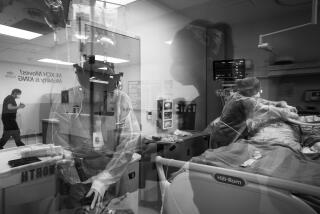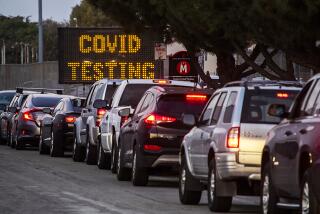Invasive heart test may be overused, researchers say
- Share via
Nearly two-thirds of those who undergo an invasive heart test called cardiac catheterization when they do not have diagnosed heart disease receive a clean bill of health, suggesting that the expensive procedure -- which exposes the patient to substantial amounts of radiation -- may be overused, researchers reported Wednesday.
Such elective testing accounts for only about 20% of all cardiac catheterizations, but the findings reported in the New England Journal of Medicine suggest that better ways should be found to identify patients who actually need the procedure.
Experts cautioned, however, that the findings should not be viewed with alarm. Just because a patient does not have a severe obstruction in the arteries “does not mean that they don’t need therapy,” said Dr. Gregg C. Fonarow, a cardiologist at UCLA’s Geffen School of Medicine who was not involved in the research. They may still need medical treatment or lifestyle alteration.
Fonarow noted that the study concluded that catheterizations had been unnecessary if artery blockage was 50% or less. However, “the majority of heart attacks occur from lesions that are less than a 50% blockage,” he said.
Dr. Steven R. Bailey of the University of Texas Health Science Center at San Antonio, who also was not involved in the study, agreed that there is value in detecting disease at its start, before it becomes a full-fledged problem. “Knowing that you have the beginnings of the disease can be a very powerful cause for people to become engaged in their clinical care,” said Bailey, who is president of the Society for Cardiovascular Angiography and Interventions.
And some of the patients who underwent the tests had been restricting activities such as exercise because of chest pains, he added. “Knowing that they don’t have significant obstructions liberates them to be more active.”
The study was conducted by Dr. Manesh Patel, a cardiologist at Duke University Medical Center, and his colleagues. They studied more than 2 million people who underwent cardiac catheterization, in which a catheter is inserted through the groin and threaded through blood vessels to examine the coronary arteries. The catheterizations had taken place at 663 hospitals that participate in the American College of Cardiology National Cardiovascular Data Registry, which tracks such procedures.
Eighty percent of the procedures were performed in patients who had previously diagnosed coronary disease or who were having a heart attack, and no one questions the value of the test in such cases. The researchers focused on the 398,978 patients who had consistent heart pains but no previous diagnosis of heart disease. About 84% of them had already had a non-invasive test that suggested the need for further testing.
Patel and his colleagues found that 37.6% of the patients had obstructive coronary artery disease, defined as more than a 50% blockage of a coronary artery. But 39.2% of patients had less than a 20% blockage while the rest had a blockage between 20% and 50%.
The data show “that up to two-thirds of the patients undergoing invasive cardiac catheterization do not have significant obstructive disease,” Patel said.
But that doesn’t mean the tests aren’t useful, Bailey said. “It’s a lot like having a colonoscopy. You don’t find something a lot of the time, but when you do, it is meaningful and changes the medical care.”
The findings “highlight an opportunity to improve . . . but should not be over-interpreted to suggest that the cardiology community is [too enthusiastic] about doing tests,” Fonarow added. “The majority of the patients did have some risk factors, and did have some pre-test possibility that disease was present. It looks like there was an attempt to follow current guidelines and appropriateness criteria.”






